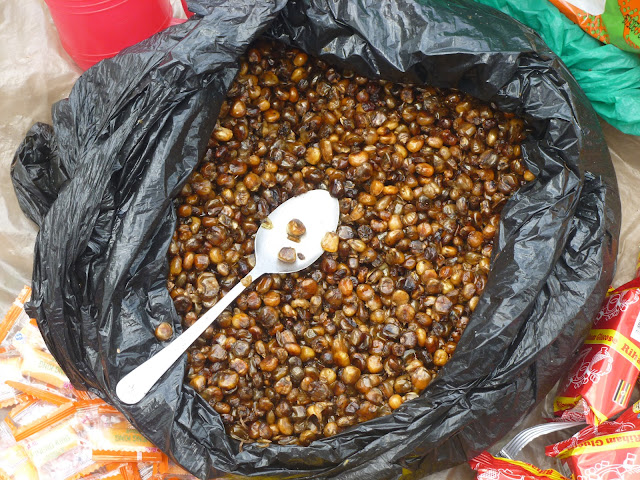If I had to describe Ugandan cuisine in one word, it would definitely
be starchy! Although there is not much variety here compared to the States, the food in Uganda is pretty good and I know I will be craving some dishes when I am back home. I don't know of any Ugandan restaurants back in NY so I will have to find some when I get back.
A traditional Ugandan meal usually consists of either a chicken, beef, fish, pea, or bean stew/curry with two to three starches as
side dishes. The main starches are rice, potatoes, sweet potato, cassava, chappati, matooke, or posho.
 |
| Pictured above are potatoes, sweet potatoes, chapatti, and cabbage with pea stew |
 |
| Rice with the pea stew |
Matooke (pronounced Matt-Okay) and posho are the dishes you
are probably not familiar with. Matooke is basically boiled plantains that are
mashed into the consistency of a much denser and thicker version of mashed
potatoes. It has the flavor of nothing.
 |
| These are the plantains that are used to make matooke. Plantains are sold anywhere and everywhere you go. It is one of the most common things you will see in Uganda. People are always selling loads of plantains along the roads. |
 |
| This is what matooke looks like after it is prepared. Although you would think it would taste like mashed bananas.. it actually has no flavor and becomes thicker the longer you let it sit out. |
Posho is a dish made out of maize corn flour (corn meal)
that is cooked with water until it forms a dough-like consistency. You usually
roll it into a ball and dip into your stew. This also tastes like nothing.
 |
| Pictured above is posho (right hand corner of the plate) with cassava and fish stew |
I also had cassava for the first time while here which more
of you may be familiar with. This is cooked and looks like a white version of a boiled
potato or sweet potato. It is much drier, starchier, and has less flavor. Feels kind of like you are eating a chalky potato. You
need a lot of water to wash it down. Alot of locals just eat it on its own as a roadside snack.
 |
| Boiled cassava- ready to peel and eat as a snack. |
When mixed with a stew or curry sauce, matooke, posho, and cassava, are much
more manageable to eat and can be somewhat tasty. I can see how you can eat it with
every meal if you grew up eating these items. When we have the option of rice,
sweet potatoes, Irish potatoes, and chappati, however, I usually tend to stick
with these options. I try to mix it up here and there.. but this is seldom.
 |
| The menu outside one of the local restaurants |
Another common food here is g-nuts (peanuts)! Roasted g-nuts
are a common snack. They taste slightly different and are slightly smaller from
the ones you find in the States. They are usually sold de-shelled, salted, and with
their red covering still intact.
 |
| A bag of roasted g-nuts are pictured right next to the bag of corn kernels. The g-nuts here are delicious. |
G-nut sauce is also eaten with your meals as a
sauce for your rice or other starch dishes. It tastes like a better version of
Thai peanut sauce and is made from boiled peanuts. It has a red/purplish color
and goes great with rice or potatoes. I want to try learning how to make it so
I can make it back in the States!
 |
| G-nut sauce! It tastes alot better than it looks. |
With so many cows, chickens, and goats everywhere, it is no
wonder that milk, eggs, chicken, and meat are actually more common here than I
expected especially in the more developed areas. When traveling, many people sell kabobs or skewers of different meat
ranging from chicken, goat, and even sausages along the roads. The vendors wait for
you to stop and invade your vehicle to persuade you to buy the items they are
selling.
 |
Pictured above is a roadside butchery- very unsanitary for
my tastes. You find many vendors selling skewers of meat in front of these
butcheries.
|
The best street food you will find here are Rolexes! Or a
fried egg/omelet wrapped in chappati bread. You can find rolexes anywhere you
go. They are simple yet delicious and filling.
 |
| The dough to make the chappati bread is rolled into egg-shaped balls |
|
  |
| The dough is then flattened and fried on a hot skillet |
 |
| the egg and chopped onions are mixed and fried to roll into the chapatti bread |
 |
| The rolex is wrapped and ready to go (the one pictured above was one where I got to add avocados- not common!) Usually rolexs only consist of fried eggs with chopped onions |
You can also find certain fruit anywhere and everywhere. Bananas are most popular. Many people just walk around with a
basket of bananas on top of their heads to sell. Alot of people fry or roast bananas along the roads as well. I eat at least one banana every day.
Pineapples are also everywhere. You always drive by trucks filled with
pineapples. Mangoes and passion fruit are very common too. Other fruits are much
harder to come by. Watermelon pops up once in a while but other than that, the
local fruits seem to be bananas, pineapples, mangoes, and passion fruit (in the
order of prevalence).
 |
| A fruit and vegetable stand along the road |
 |
| One of my favorite
fruits are mangoes. My mom would buy a big box of mangoes from the Korean market
just for me when I was growing up because she knew I would finish them all. I am so happy to find sweet and delicious mangoes everywhere in Uganda! |
While the local food is fresh and delicious, I really miss a
lot of the food back home that I am unable to get here……..some of which are......
 |
| sushi! |
 |
| good sushi |
 |
| My mom's Korean cooking with banchan, kimchi, and daenjangjigae |
 |
| Fro yo! |
 |
| macarons! |
Not having the luxury of U.S. food options here makes me definitely appreciate all the food I usually take advantage of. The food here, however, has been great and I will be craving g-nut sauce and rolexes back home. Caitlin and I are already talking about the food that we have to learn how to make or find for our Ugandan dinner get together when we are back in New York.
Enjala ennuma!





















































